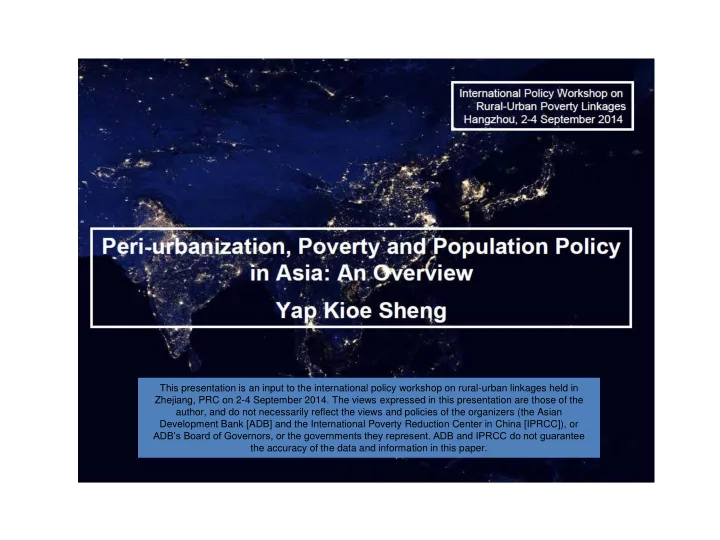

This presentation is an input to the international policy workshop on rural-urban linkages held in Zhejiang, PRC on 2-4 September 2014. The views expressed in this presentation are those of the author, and do not necessarily reflect the views and policies of the organizers (the Asian Development Bank [ADB] and the International Poverty Reduction Center in China [IPRCC]), or ADB’s Board of Governors, or the governments they represent. ADB and IPRCC do not guarantee the accuracy of the data and information in this paper.
Some see a future cross- border mega-urban corridor linking large cities and including small cities, towns and rural areas
Peri-urbanization
Environmental degradation and groundwater extraction
Factories amidst the fields; Affordable factory workers is waste properly treated? housing, but a planner’s nightmare
Housing estates between coconut plantations Middle-income housing next to rice fields Each housing estate has its own private bridge to commute to the city by private car
Aerotropolis
Green belts are difficult to protect Suvarnabhumi Aerotropolis
Aerotropolis
Problems of peri-urbanization, as “urban meets rural”: • poverty among farmers; possible urban food insecurity • inefficient urban development patterns • environmental conflicts and degradation • lack of employment for the poor evicted from the city Peri-urbanization is as a set of processes, driven by a range of agents who are attracted by lower land values and increasing road access. The processes do not occur at the same place, at same time and at same speed
Superblock 1974 Superblock 1984 Superblock 2012
Views on peri-urban areas differ; they are seen as: • a transition phase between rural and urban development • an unique new type of mixed urban-rural development • a threat to the eco-system of mega-urban regions This raises two questions: • Is peri-urbanization the best way to expand urban areas and can it be done in a better way? • Is expansion of mega-cities acceptable or should growth be distributed over more cities, and if so, how can this be done?
The importance of developing smaller cities
Urban population by settlement size (2000-2010) Percentage of urban Population (millions) population 2000 2010 2000 2010 10 m + 152.7 234.5 11.7 13.8 5-10 m 129.3 181.3 9.9 10.7 1-5 m 144.6 181.1 11.1 10.7 0.5-1 m 125.3 176.6 9.6 10.4 <0.5 m 749.1 926.4 57.6 54.5 Total urban 1,301.0 1,699.8 100.0 100.0 Total rural 2,468.0 2,479.6 Total 3,769.0 4,179.5 Definitions of “urban” differ from country to country.
The large city is the engine of economic growth Thailand GRP per capita (2012) Region US$/year Growth rate East 13,307 9.8 Bangkok 11,314 8.6 Central 7,123 8.8 South 3,928 -4.7 North 2,891 16.1 Northeast 2,135 12.3 Thailand 5,780 8.8 Differences in economic opportunity have led to massive migration to Bangkok
Battambang, Cambodia Capacity development in smaller cities is critical Taunggyi, Shan State, Myanmar
Large cities will always attract private and public investments Small-city development requires at local level: at national level: • economic potential • long-term political and • urban management capacity financial commitments • inclusive urban policies • “genuine” devolution
National Urban Development Strategy (NUDS) Laissez-faire policies lead to continued mega-city growth, until diseconomies overwhelm the city, but when is that? Alternative national urban development strategies: • Development of a distinct new urban hierarchy with a large city, smaller cities and towns in a backward region • Polycentric and urban corridor development: promote centres within or somewhat outside the large city
Natural growth is often the main factor in urban growth, so large cities will continue to grow. Whatever the NUDS, peri- urbanization as such also needs to be addressed Components of urban population growth in India (%) 1961-1971 1971-1981 1981-1991 1991-2001 2001-2011 Natural increase 64.6 51.3 61.3 59.4 44 Migration 18.7 19.6 21.7 21.0 25 Reclassification 13.8 14.8 9.4 6.2 30 Urban expansion 2.9 14.2 7.6 13.0 Components of urban population growth in Thailand and Bangkok (%) 1960-1970 1970-1980 1980-1990 1990-2000 TH BKK TH BKK TH BKK TH BKK Natural growth 70.4 59.2 37.7 29.4 47.1 69.4 13.0 69.8 Net migration 15.4 5.6 5.2 6.7 13.9 30.6 11.5 30.2 Reclassification 14.2 35.2 57.1 63.9 39.0 - 75.5 -
Planning mega-urban expansion
Questions about peri-urbanization: • Should peri-urbanization continue with minimal planning as the most practical form of urbanization? • Do local and national governments have the capacity and political willingness to plan peri-urbanization? • As the urban poor are evicted from the city to peri-urban areas, how can peri-urban poverty be reduced? • Should the peri-urban natural resources be protected as a critical part of the eco-system of the mega-city?
It is “easy” to make plans for urban expansion; the problem lies in implementation, as many public and private, national and local, rich and poor stakeholders are involved Angel recommends a minimalist approach: • enlarge city boundaries for expected urban expansion • ensure adequate land supply to meet growing demand • prepare plans for future infrastructure provision • acquire spaces of sensitive habitats and nature parks • develop arterial road network to guide the processes
Land readjustment can lead to more efficient development and free land for housing the poor, but most landowners are unwilling
Urban and peri-urban poverty reduction
Urban poverty implies a lack of: • income to meet basic needs • capabilities to live in dignity Adequate housing and access to services improve capabilities Housing must have easy access to centres of economic opportunity Services include safe water and sanitation, education and health care, credit and information, transport etc. As peri-urban areas urbanize, urban centres emerge. Until then peri-urban life is difficult for the poor
In small cities, providing land and services is easier, but large cities offer more economic opportunities and better services City centres are better for the poor than urban peripheries, but land values and cost of living in urban centres are higher From a locational perspective, poor households must strike a balance and may apply multi-locational income strategies As markets prevail, the poor must be empowered to negotiate with local government, landowners and private employers
Thank You
Recommend
More recommend